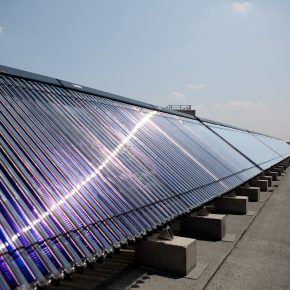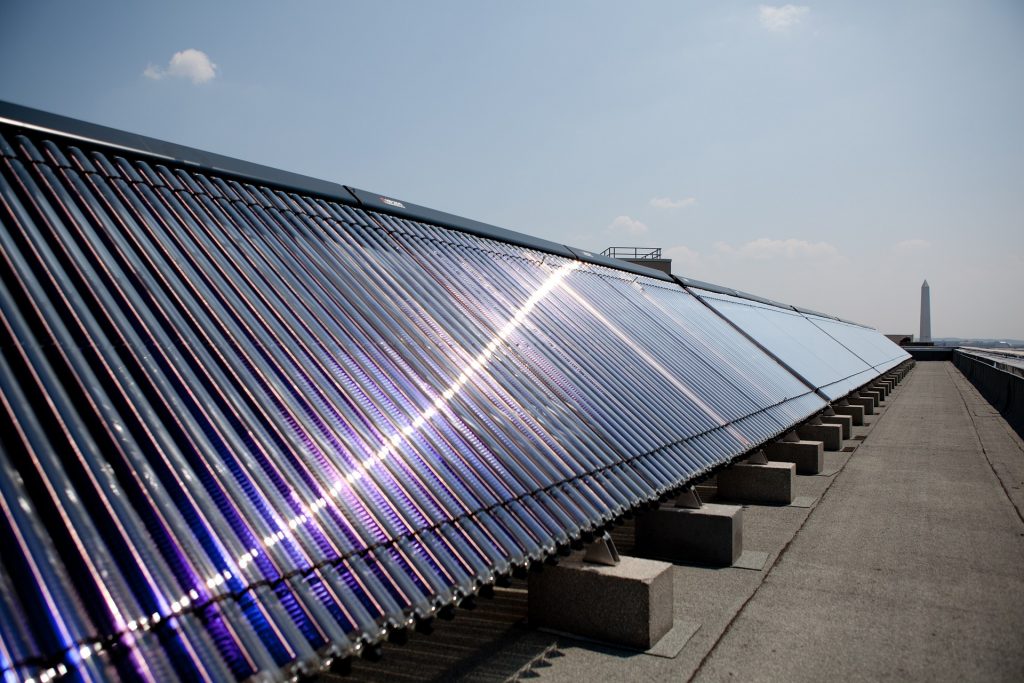
Invaluable Solar Water Heating Set-Up Tips
With a rising interest in renewable technology (solar energy in particular), many households are considering installations such as that of a solar water heaters.
Naturally, by choosing the right solar water heating setup, you can help customers maximise the various potential advantages of this technology
Solar water heaters are beneficial either way, of course. After all, solar energy is free energy. You don’t need to spend a penny to run a solar water heater, meaning that they can pay for themselves over time.
Solar water heating can ultimately reduce household bills by around £150 to £300. However, household savings may be even greater with the ideal setup, so why not take this into account when advising clients on the best solar water heater setup?
Choosing The Right Type of Solar Water Heater
Note: Only an MCS-certified installer may install a solar water heating system.
There are two primary ways of categorizing solar water heaters; the type of solar technology design used and the location of the solar water heater. For this section, we’ll focus on the former.
When it comes to the design of a solar water heater, there are two options:
– Evacuated tubes
– Flat plate collectors
Evacuated tubes are glass tubes that are mounted to the roof tiles of a property. They are held together in structures known as banks. Evacuated tubes have a distinct look as far as solar technology goes, with a similar appearance to the interior of a roller grill.
Flat plate collectors, however, more closely resemble conventional solar panels. These flat plate collectors could be fitted atop the roof or integrated into the roof to appear more seamless. Alternatively, they may be ground-mounted, but more on that shortly.
So how exactly do evacuate tubes and flat plate collectors differ? As you probably already know, evacuated tubes are more efficient and can perform better in low temperatures. This makes evacuated tubes a smart option in the UK, especially for regions of the country prone to particularly low temperatures. So, if you are an installer in say the Scottish Highlands, you may consider evacuated tubes the best option for your customers.
Flat plate collectors may suffice, however, depending on the size of the property and a range of other factors. If the household in question does not require a large quantity of hot water, flat plate collectors may do the job.
Flat plate collectors tend to be a little cheaper too, so, customers living in small properties with a low hot water demand could benefit from this option. All in all, it will be a matter of deciding on a case-by-case basis.
The Correct Installation Location
Where you set up the evacuated tubes or flat plate collector is another key consideration if you want to make the most of a solar water heating system for each given client.
Customers may assume that a solar water heater can only be added to a roof, but, if there is sufficient and suitable space, you should also discuss the possibility of a ground-mounted setup to see if they are interested. After all, in some cases, this may be the most efficient choice.
Of course, ground-mounted solar water heaters are generally not well-suited to urban environments due to a relative lack of space and the likelihood that they will not have sufficient access to solar energy throughout the day.
However, if you are working for a customer with a large open space in a rural environment (or somewhere in between the two extremes mentioned here), a ground-mounted system may be the best option. You should spend time making a range of calculations to determine the efficiency and running costs of different setups as opposed to making broad estimates.

If a customer has a south-facing roof with few or no sources obscuring sunlight from any direction, then there’s a strong chance that this will be the ideal setup. Of course, the strength of the roof (and whether it will require any upgrades to hold up the solar technology installation) must also be taken into account.
If a customer has an east- or west-facing roof or/and any roof with substantial sources of light blockage (e.g., a large building nearby that largely blocks the sun from reaching the roof area for a significant portion of the day), then a ground mounted setup may be more efficient, if feasible.
As for the dreaded north-facing roof, as you know, this is pretty much a no-go for a solar technology setup. However, assuming that the back-facing roof of the property faces north, you should make the case to your client to keep an open mind about opting for a front-facing roof setup, allowing for a south-facing installation.
To make the case to sceptical customers, consider raising the following points:
– Even with solar roof instalments on the front of the house, planning permission is generally not required once other measures are met.
– Integrated flat plate collectors may be added to your front roof rather than protruding flat plate collectors. That way, the solar installation can be made more seamless and prove less of an eye sore
– Solar roof installations on the front of properties are increasingly common in the UK today.
You don’t want to spend too much time trying to convince customers to opt for a front-roof setup unless they are genuinely interested. Otherwise, you may end up causing frustration and a level of tension and merely delaying the process.
Other Suitability Considerations
When working out the best solar water heating setup along with customer input and approval, you’ll also want to consider whether the property’s boiler is a suitable match for a solar water heating system.
While regular boilers and system boilers can be compatible with solar water heating, the same cannot be said of combi boilers. For properties with a combi boiler, you’d have to install a separate solar hot water cylinder. Therefore, it’s important to verify well in advance whether the property has sufficient space for adding a solar hot water cylinder.
Beyond that, properties with regular boilers and system boilers may require a new hot water cylinder installation too. This is because the existing hot water cylinders associated with these boilers are usually not sufficient to work with a solar water heater, although in some lucky cases, they are.
If a larger hot water cylinder is needed, this would require more space and so you’ll need to verify first that the household has adequate space for the safe instalment of a new, larger hot water cylinder if this is required.
Next, you’ll want to take into account what setup is most likely to fall under permitted development. If planning permission is required, this is not the end of the world.
However, if it can be avoided without taking away from the efficiency and advantages of the system or adding to the installation cost, it’s worth taking this on board.
If the property is located in a conservation area or national park or is a listed building, planning permission may very well be required.
Planning permission rules to consider include:
– The roof must be sufficient to hold up the solar water heating technology
– If an additional water cylinder is required, there must be sufficient space to safely undertake this installation.
More details on planning permission and permitting the development of a solar thermal system may be found through the Planning Portal.
Remember to consider various angles (as discussed in this article and any more that may arise with a given property) before deciding what solar water heating setup is ideal for any given customer. Of course, customers may not always agree with your proposed setup, but it is worth aiming for the optimal installation where possible.
Latest news

28th February 2025
Passivent ventilation solutions are top of the class
Passivent has supplied a combination of Hybrid Plus2 Aircool ventilators and Hybrid Plus Airstract roof ventilation terminals for a new London primary school.
Posted in Air Conditioning, Articles, Building Industry News, Building Products & Structures, Building Services, Case Studies, Ceilings, Facility Management & Building Services, Heating, Ventilation and Air Conditioning - HVAC, Restoration & Refurbishment, Retrofit & Renovation, Roofs, Sustainability & Energy Efficiency, Ventilation, Walls
28th February 2025
Troldtekt: New acoustic liner ensures good acoustics and easy handling
Both a building’s users and its developers have a good reason to get excited about the new Troldtekt Plus 25 panels. This specially developed acoustic panel sets a high standard for both sound absorption and building efficiency.
Posted in Acoustics, Noise & Vibration Control, Articles, Building Industry News, Building Products & Structures, Building Services, Building Systems, Ceilings, Facility Management & Building Services, Floors, Innovations & New Products, Insulation, Interior Design & Construction, Interiors, Restoration & Refurbishment, Retrofit & Renovation, Timber Buildings and Timber Products, Walls
28th February 2025
InstallerSHOW 2025 – Registration is now OPEN!
Building on the success of last year, InstallerSHOW is returning to the NEC from the 24th to the 26th of June…
Posted in Articles, Building Industry Events, Building Industry News, Building Products & Structures, Building Services, Exhibitions and Conferences, Health & Safety, Retrofit & Renovation, Seminars, Sustainability & Energy Efficiency
28th February 2025
ABLOY securing Helsinki’s heritage and Croatia’s waste management
ABLOY, part of ASSA ABLOY Group, has redefined its brand, focusing on the value it brings to customers around the world…
Posted in Access Control & Door Entry Systems, Architectural Ironmongery, Articles, Building Industry News, Building Products & Structures, Building Services, Case Studies, Doors, Facility Management & Building Services, Health & Safety, Retrofit & Renovation, Security and Fire Protection
 Sign up:
Sign up: